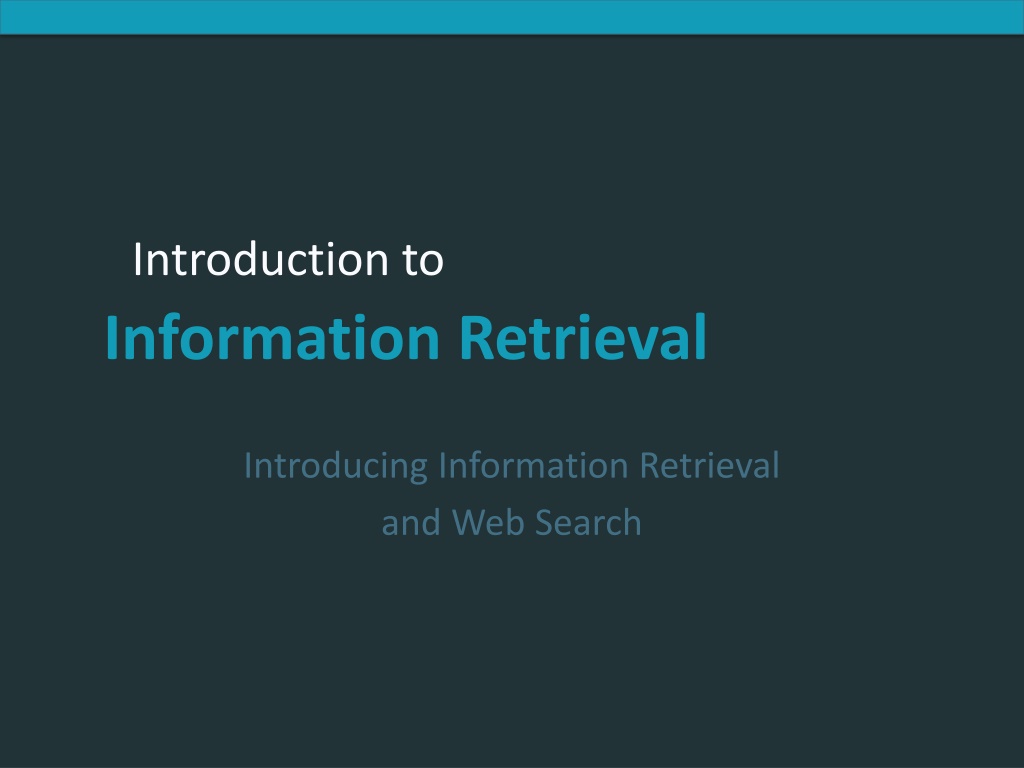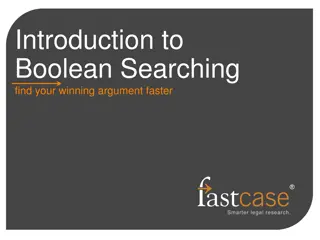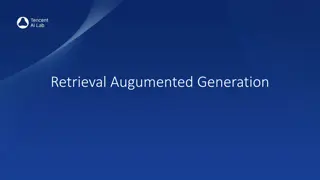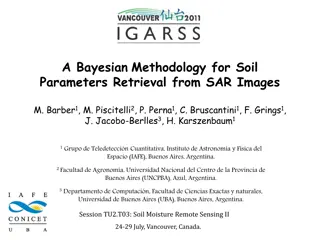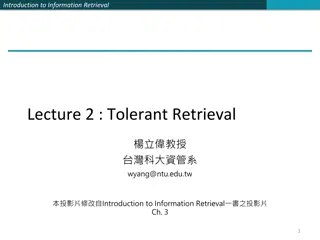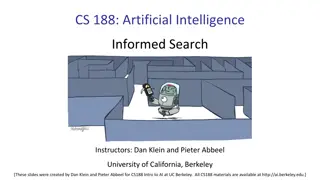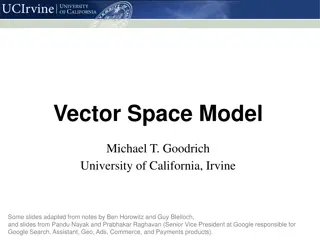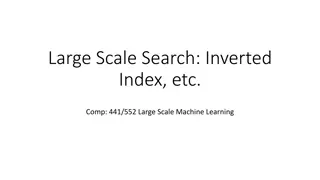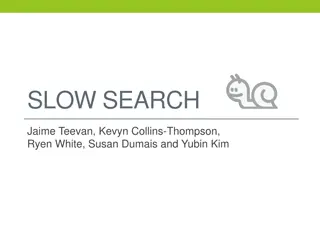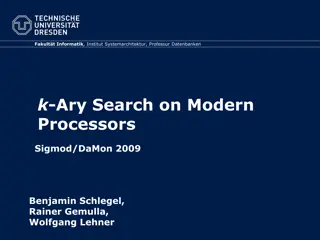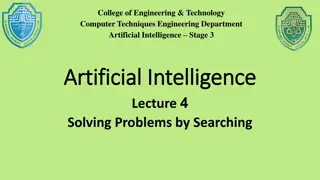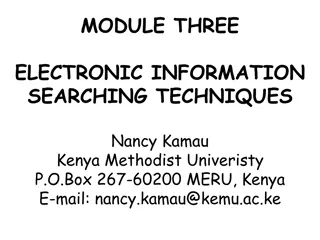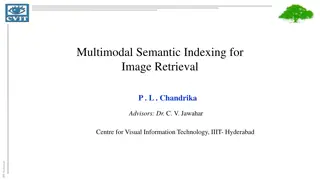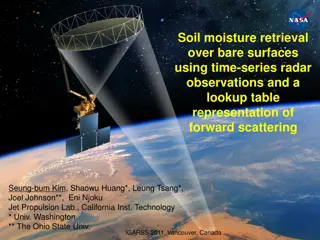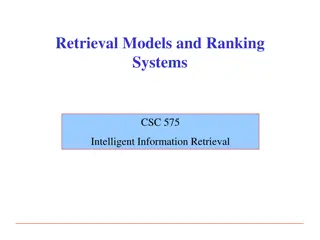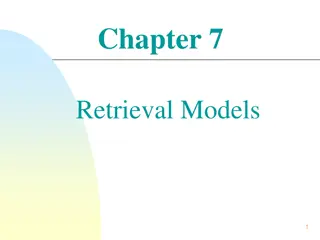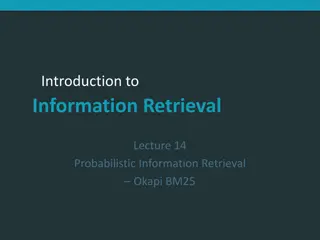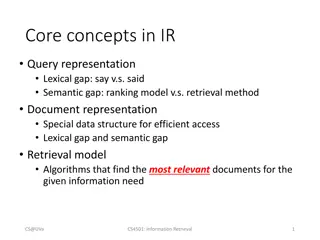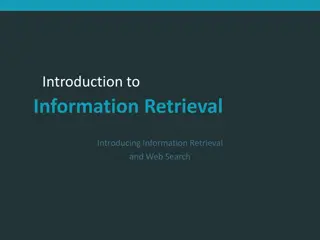Introduction to Information Retrieval and Web Search
Information Retrieval (IR) involves finding unstructured material, typically text documents, within large collections stored on computers to satisfy information needs. This process extends beyond web search to include email search, corporate knowledge bases, and legal information retrieval. The text explores the differences between unstructured and structured data, the basic assumptions of information retrieval, the classic search model, and the assessment of retrieved documents' precision and recall.
Download Presentation

Please find below an Image/Link to download the presentation.
The content on the website is provided AS IS for your information and personal use only. It may not be sold, licensed, or shared on other websites without obtaining consent from the author.If you encounter any issues during the download, it is possible that the publisher has removed the file from their server.
You are allowed to download the files provided on this website for personal or commercial use, subject to the condition that they are used lawfully. All files are the property of their respective owners.
The content on the website is provided AS IS for your information and personal use only. It may not be sold, licensed, or shared on other websites without obtaining consent from the author.
E N D
Presentation Transcript
Introduction to Information Retrieval Introduction to Information Retrieval Introducing Information Retrieval and Web Search
Introduction to Information Retrieval Information Retrieval Information Retrieval (IR) is finding material (usually documents) of an unstructured nature (usually text) that satisfies an information need from within large collections (usually stored on computers). These days we frequently think first of web search, but there are many other cases: E-mail search Searching your laptop Corporate knowledge bases Legal information retrieval 2
Introduction to Information Retrieval Unstructured (text) vs. structured (database) data in the mid-nineties 250 200 150 Unstructured Structured 100 50 0 Data volume Market Cap 3
Introduction to Information Retrieval Unstructured (text) vs. structured (database) data today 250 200 150 Unstructured Structured 100 50 0 Data volume Market Cap 4
Sec. 1.1 Introduction to Information Retrieval Basic assumptions of Information Retrieval Collection: A set of documents Assume it is a static collection for the moment Goal: Retrieve documents with information that is relevant to the user s information need and helps the user complete a task 5
Introduction to Information Retrieval The classic search model Get rid of mice in a politically correct way User task Misconception? Info about removing mice without killing them Info need Misformulation? Query Search how trap mice alive Search engine Query refinement Results Collection
Sec. 1.1 Introduction to Information Retrieval How good are the retrieved docs? Precision : Fraction of retrieved docs that are relevant to the user s information need Recall : Fraction of relevant docs in collection that are retrieved More precise definitions and measurements to follow later 7
Introduction to Information Retrieval Introduction to Information Retrieval Term-document incidence matrices
Sec. 1.1 Introduction to Information Retrieval Unstructured data in 1620 Which plays of Shakespeare contain the words Brutus ANDCaesar but NOTCalpurnia? One could grepall of Shakespeare s plays for Brutus and Caesar, then strip out lines containing Calpurnia? Why is that not the answer? Slow (for large corpora) NOTCalpurnia is non-trivial Other operations (e.g., find the word Romans near countrymen) not feasible Ranked retrieval (best documents to return) Later lectures 10
Sec. 1.1 Introduction to Information Retrieval Term-document incidence matrices Antony and Cleopatra Julius Caesar The Tempest Hamlet Othello Macbeth 1 1 0 0 0 1 Antony 1 1 0 1 0 0 Brutus 1 1 0 1 1 1 Caesar 0 1 0 0 0 0 Calpurnia 1 0 0 0 0 0 Cleopatra 1 0 1 1 1 1 mercy 1 0 1 1 1 0 worser 1 if play contains word, 0 otherwise BrutusANDCaesarBUTNOT Calpurnia
Sec. 1.1 Introduction to Information Retrieval Incidence vectors So we have a 0/1 vector for each term. To answer query: take the vectors for Brutus, Caesar and Calpurnia (complemented) bitwise AND. 110100 AND 110111 AND 101111 = 100100 Antony 1 Antony and Cleopatra Julius Caesar The Tempest Hamlet Othello Macbeth 1 0 0 0 1 1 1 0 1 0 0 Brutus 1 1 0 1 1 1 Caesar 0 1 0 0 0 0 Calpurnia 1 0 0 0 0 0 Cleopatra 1 0 1 1 1 1 mercy 1 0 1 1 1 0 worser 12
Sec. 1.1 Introduction to Information Retrieval Answers to query Antony and Cleopatra,Act III, Scene ii Agrippa [Aside to DOMITIUS ENOBARBUS]: Why, Enobarbus, When Antony found Julius Caesar dead, He cried almost to roaring; and he wept When at Philippi he found Brutus slain. Hamlet, Act III, Scene ii Lord Polonius: I did enact Julius Caesar I was killed i the Capitol; Brutus killed me. 13
Sec. 1.1 Introduction to Information Retrieval Bigger collections Consider N = 1 million documents, each with about 1000 words. Avg 6 bytes/word including spaces/punctuation 6GB of data in the documents. Say there are M = 500K distinct terms among these. 14
Sec. 1.1 Introduction to Information Retrieval Can t build the matrix 500K x 1M matrix has half-a-trillion 0 s and 1 s. But it has no more than one billion 1 s. matrix is extremely sparse. Why? What s a better representation? We only record the 1 positions. 15
Introduction to Information Retrieval Introduction to Information Retrieval The Inverted Index The key data structure underlying modern IR
Sec. 1.2 Introduction to Information Retrieval Inverted index For each term t, we must store a list of all documents that contain t. Identify each doc by a docID, a document serial number Can we used fixed-size arrays for this? 1 2 4 11 31 45173 174 Brutus 1 2 4 5 6 16 57 132 Caesar 2 31 54101 Calpurnia What happens if the word Caesar is added to document 14? 18
Sec. 1.2 Introduction to Information Retrieval Inverted index We need variable-size postings lists On disk, a continuous run of postings is normal and best In memory, can use linked lists or variable length arrays Some tradeoffs in size/ease of insertion Posting 1 2 4 11 31 45173 174 Brutus 1 2 4 5 6 16 57 132 Caesar 2 31 54101 Calpurnia Postings Dictionary Sorted by docID (more later on why). 19
Sec. 1.2 Introduction to Information Retrieval Inverted index construction Documents to be indexed Friends, Romans, countrymen. Tokenizer Friends Romans Countrymen Token stream Linguistic modules friend roman countryman Modified tokens 2 4 Indexer friend 1 2 roman Inverted index 16 13 countryman
Introduction to Information Retrieval Initial stages of text processing Tokenization Cut character sequence into word tokens Deal with John s , a state-of-the-art solution Normalization Map text and query term to same form You want U.S.A. and USA to match Stemming We may wish different forms of a root to match authorize, authorization Stop words We may omit very common words (or not) the, a, to, of
Sec. 1.2 Introduction to Information Retrieval Indexer steps: Token sequence Sequence of (Modified token, Document ID) pairs. Doc 1 Doc 2 I did enact Julius Caesar I was killed i the Capitol; Brutus killed me. So let it be with Caesar. The noble Brutus hath told you Caesar was ambitious
Sec. 1.2 Introduction to Information Retrieval Indexer steps: Sort Sort by terms At least conceptually And then docID Core indexing step
Sec. 1.2 Introduction to Information Retrieval Indexer steps: Dictionary & Postings Multiple term entries in a single document are merged. Split into Dictionary and Postings Doc. frequency information is added. Why frequency? Will discuss later.
Sec. 1.2 Introduction to Information Retrieval Where do we pay in storage? Lists of docIDs Terms and counts IR system implementation How do we index efficiently? How much storage do we need? Pointers 26
Introduction to Information Retrieval Introduction to Information Retrieval Query processing with an inverted index
Sec. 1.3 Introduction to Information Retrieval The index we just built How do we process a query? Later what kinds of queries can we process? Our focus 29
Sec. 1.3 Introduction to Information Retrieval Query processing: AND Consider processing the query: BrutusANDCaesar Locate Brutus in the Dictionary; Retrieve its postings. Locate Caesar in the Dictionary; Retrieve its postings. Merge the two postings (intersect the document sets): 2 1 4 2 8 3 16 5 32 8 64 128 Brutus Brutus Caesar Caesar 13 21 34 30
Sec. 1.3 Introduction to Information Retrieval The merge Walk through the two postings simultaneously, in time linear in the total number of postings entries 2 1 4 2 8 3 16 5 128 32 8 64 Brutus Brutus Caesar Caesar 13 21 34 If the list lengths are x and y, the merge takes O(x+y) operations. Crucial: postings sorted by docID. 31
Introduction to Information Retrieval Intersecting two postings lists (a merge algorithm) 33
Introduction to Information Retrieval Introduction to Information Retrieval The Boolean Retrieval Model & Extended Boolean Models
Sec. 1.3 Introduction to Information Retrieval Boolean queries: Exact match The Boolean retrieval model is being able to ask a query that is a Boolean expression: Boolean Queries are queries using AND, OR and NOT to join query terms Views each document as a set of words Is precise: document matches condition or not. Perhaps the simplest model to build an IR system on Primary commercial retrieval tool for 3 decades. Many search systems you still use are Boolean: Email, library catalog, macOS Spotlight 36
Sec. 1.4 Introduction to Information Retrieval Example: WestLaw http://www.westlaw.com/ Largest commercial (paying subscribers) legal search service (started 1975; ranking added 1992; new federated search added 2010) Tens of terabytes of data; ~700,000 users Majority of users still use boolean queries Example query: What is the statute of limitations in cases involving the federal tort claims act? LIMIT! /3 STATUTE ACTION /S FEDERAL /2 TORT /3 CLAIM /3 = within 3 words, /S = in same sentence 37
Sec. 1.4 Introduction to Information Retrieval Example: WestLaw http://www.westlaw.com/ Another example query: Requirements for disabled people to be able to access a workplace disabl! /p access! /s work-site work-place (employment /3 place Note that SPACE is disjunction, not conjunction! Long, precise queries; proximity operators; incrementally developed; not like web search Many professional searchers still like Boolean search You know exactly what you are getting But that doesn t mean it actually works better .
Sec. 1.3 Introduction to Information Retrieval Boolean queries: More general merges Exercise: Adapt the merge for the queries: BrutusAND NOTCaesar BrutusOR NOTCaesar Can we still run through the merge in time O(x+y)? What can we achieve? 39
Sec. 1.3 Introduction to Information Retrieval Merging What about an arbitrary Boolean formula? (BrutusOR Caesar) AND NOT (Antony OR Cleopatra) Can we always merge in linear time? Linear in what? Can we do better? 40
Sec. 1.3 Introduction to Information Retrieval Query optimization What is the best order for query processing? Consider a query that is an AND of n terms. For each of the n terms, get its postings, then AND them together. 2 4 8 16 32 64128 Brutus 1 2 3 5 8 16 21 34 Caesar 13 16 Calpurnia Query: BrutusANDCalpurniaANDCaesar 41
Sec. 1.3 Introduction to Information Retrieval Query optimization example Process in order of increasing freq: start with smallest set, then keep cutting further. This is why we kept document freq. in dictionary 2 4 8 16 32 64128 Brutus 1 2 3 5 8 16 21 34 Caesar 13 16 Calpurnia Execute the query as (CalpurniaANDBrutus)AND Caesar. 42
Introduction to Information Retrieval Exercise Recommend a query processing order for (tangerine OR trees) AND (marmalade OR skies) AND (kaleidoscope OR eyes) Term eyes kaleidoscope marmalade skies tangerine trees Freq 213312 87009 107913 271658 46653 316812 Which two terms should we process first? 43
Sec. 1.3 Introduction to Information Retrieval More general optimization e.g., (madding OR crowd) AND (ignoble OR strife) Get doc. freq. s for all terms. Estimate the size of each OR by the sum of its doc. freq. s (conservative). Process in increasing order of OR sizes. 44
Introduction to Information Retrieval Query processing exercises Exercise: If the query is friendsAND romans AND (NOT countrymen), how could we use the freq of countrymen? Exercise: Extend the merge to an arbitrary Boolean query. Can we always guarantee execution in time linear in the total postings size? Hint: Begin with the case of a Boolean formula query: in this, each query term appears only once in the query. 45
Introduction to Information Retrieval Exercise Try the search feature at http://www.rhymezone.com/shakespeare/ Write down five search features you think it could do better 46
Introduction to Information Retrieval Introduction to Information Retrieval Phrase queries and positional indexes
Sec. 2.4 Introduction to Information Retrieval Phrase queries We want to be able to answer queries such as stanford university as a phrase Thus the sentence I went to university at Stanford is not a match. The concept of phrase queries has proven easily understood by users; one of the few advanced search ideas that works Many more queries are implicit phrase queries For this, it no longer suffices to store only <term : docs> entries
Sec. 2.4.1 Introduction to Information Retrieval A first attempt: Biword indexes Index every consecutive pair of terms in the text as a phrase For example the text Friends, Romans, Countrymen would generate the biwords friends romans romans countrymen Each of these biwords is now a dictionary term Two-word phrase query-processing is now immediate.
Sec. 2.4.1 Introduction to Information Retrieval Longer phrase queries Longer phrases can be processed by breaking them down stanford university palo alto can be broken into the Boolean query on biwords: stanford university AND university palo AND palo alto Without the docs, we cannot verify that the docs matching the above Boolean query do contain the phrase. Can have false positives!
Sec. 2.4.1 Introduction to Information Retrieval Issues for biword indexes False positives, as noted before Index blowup due to bigger dictionary Infeasible for more than biwords, big even for them Biword indexes are not the standard solution (for all biwords) but can be part of a compound strategy
Sec. 2.4.2 Introduction to Information Retrieval Solution 2: Positional indexes In the postings, store, for each term the position(s) in which tokens of it appear: <term, number of docs containing term; doc1: position1, position2 ; doc2: position1, position2 ; etc.>
Sec. 2.4.2 Introduction to Information Retrieval Positional index example <be: 993427; 1: 7, 18, 33, 72, 86, 231; 2: 3, 149; 4: 17, 191, 291, 430, 434; 5: 363, 367, > Which of docs 1,2,4,5 could contain to be or not to be ? For phrase queries, we use a merge algorithm recursively at the document level But we now need to deal with more than just equality
Sec. 2.4.2 Introduction to Information Retrieval Processing a phrase query Extract inverted index entries for each distinct term: to, be, or, not. Merge their doc:position lists to enumerate all positions with to be or not to be . to: 2:1,17,74,222,551; 4:8,16,190,429,433; 7:13,23,191; ... be: 1:17,19; 4:17,191,291,430,434; 5:14,19,101; ... Same general method for proximity searches
Sec. 2.4.2 Introduction to Information Retrieval Proximity queries LIMIT! /3 STATUTE /3 FEDERAL /2 TORT Again, here, /kmeans within kwords of . Clearly, positional indexes can be used for such queries; biword indexes cannot. Exercise: Adapt the linear merge of postings to handle proximity queries. Can you make it work for any value of k? This is a little tricky to do correctly and efficiently See Figure 2.12 of IIR
Sec. 2.4.2 Introduction to Information Retrieval Positional index size A positional index expands postings storage substantially Even though indices can be compressed Nevertheless, a positional index is now standardly used because of the power and usefulness of phrase and proximity queries whether used explicitly or implicitly in a ranking retrieval system.
